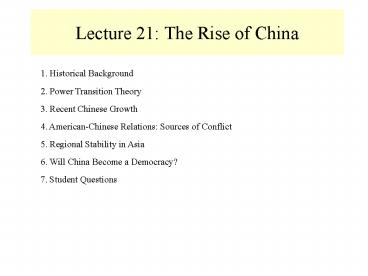Lecture 21: The Rise of China - PowerPoint PPT Presentation
1 / 23
Title:
Lecture 21: The Rise of China
Description:
Lecture 21: The Rise of China. 1. Historical Background. 2. Power Transition Theory ... Long History of Conflict. 1980's: Chinese Cuts in Defense Spending ... – PowerPoint PPT presentation
Number of Views:53
Avg rating:3.0/5.0
Title: Lecture 21: The Rise of China
1
Lecture 21 The Rise of China
1. Historical Background 2. Power Transition
Theory 3. Recent Chinese Growth 4.
American-Chinese Relations Sources of
Conflict 5. Regional Stability in Asia 6. Will
China Become a Democracy? 7. Student Questions
2
Historical Background
End of the Ching Dynasty (1644-1911)
1911
Instability, Revolts, Invasions, and Civil War
Maos Communist Victory
1949
1950
Intervention in the Korean War (November)
Decay of Chinese-Soviet Relations
1966
Soviet-Chinese Border Clashes
1969
Cultural Revolution
1972
Nixon Plays the China Card
1976
Death of Mao
1978
Market Reforms Begin Slowly
2001
3
A Success Story
Average Annual Time Period
Growth 1960-1978 (pre-reform) 5.3 1979-1999
(post-reform) 9.7 1991 9.3 1992 14.2 1993 13.5 19
94 12.7 1995 10.5 1996 9.7 1997 8.8 1998 7.8 1999
7.1 2000 (Jan-June) 8.2 Source Morrison 2000
4
Power Transition Theory
The Within Country Power Transition
GROSS NATIONAL PRODUCT
POWER TRANSITION POINT
TIME
The Between Country Power Transition
RISING CHALLENGER
DECLINING HEGEMON
GROSS NATIONAL PRODUCT
THE CROSS OVER POINT
TIME
5
Two Key Questions
Will China Surpass the U.S.?
Is China Dissatisfied?
6
Measuring Size and Growth Rate
Problem 1 How Big Is The Chinese Economy?
Nominal GDP Nominal PPP Country GDP B PPP
B GDP GDP --------- -------- ------- per capita
per capita U.S. 9,234 9,234 33,835 33,835 Japan 4
,370 2,935 34,519 23,465 Germany 2,111 1,748 25,69
4 21,841 China 997 5,201 790 4,228
Problem 2 How Fast Will It Grow?
7
(No Transcript)
8
Transitions and Conflict
Yes, But China Starts Out Significantly Behind
the U.S. Yes, But a Moderately Long Lead Time
Exists
Will China Surpass the U.S.?
Yes Rejects World Run by Capitalists
Democrats Yes Demands Prestige (or its Place in
the Sun) Yes Supports Revolutionary Forces
Abroad No Not Territorially Expansionist No
Increasingly Integrated in International
System No Needs Investment, Trade, and Technology
Is China Dissatisfied?
9
Source U.S. Embassy in China, Trade Investment
Briefing
10
(No Transcript)
11
(No Transcript)
12
Singapore
Taiwan
Other
USA
Japan
Hong Kong
13
(No Transcript)
14
Sources of U.S.-China Conflict
- Trade
- Human Rights
- Taiwan
15
Sources of U.S.-China Conflict Trade
- Growing U.S. Trade Deficit With China
- 1999 U.S. Exports to China 13.12
- 1999 U.S. Imports From China 87.78
- Will Chinese Membership in the WTO Lessen
Conflict? - a) Regime Will Encourage China to Cooperate
- b) WTO is Impartial Monitor
- c) Concessions are to a Third Party
- d) Keeps Conflict from Spreading
16
Sources of U.S.-China Conflict Human Rights
- Tiananmen Square (June 1989) Response
- Chinese Perspective Question of Sovereignty
- American Perspective Moral Obligation
- -- Idealism
- -- President Carter Shift in U.S. Policy
- -- New International Norm Protecting Human
Rights
17
Sources of U.S.-China Conflict Taiwan
- Legacy of Civil War 1949 Communist Victory
- Korean War Links U.S. to Defense of Taiwan
- Series of Taiwan Straits Crises During the
Cold War - U.S. Establishes Bi-Lateral Relations with PRC
in 1979 - Recent Democratization of Taiwan
- Military and Economic Costs of a Chinese
Invasion - Can the U.S. Deter China in Any Way?
18
(No Transcript)
19
Regional Stability Chinas Relations with its
Neighbors
- Long History of Conflict
- 1980s Chinese Cuts in Defense Spending
- 1990s Defense Build Up Begins
- a) Reorder Defense Focus
- b) Impact of the 1991 Persian Gulf War
- c) Typical Patter for a Developing Country
- d) Buy Off the Military
- Response to Buildup Private Alarm Public
Appeasement - Chinas Biggest Fear A Re-Armed Japan
20
(No Transcript)
21
A Comment on the Build-Up
- In Percentage Terms, the Build-Up is Alarming
- But Percentages can be Misleading
Defense Spending (U.S.b)
Defense as a of GDP
GDP (U.S.t)
U.S. China
8.5 4.4
267 36
3 1
1998 Estimates from CIA Fact Book CIA states
that official Chinese Defense Spending is 12b
IISS estimates it at 36b
22
Will China Become A Democracy?
- Tiananmen Square 1989
- General Hypothesis
- Economic Development ---()---gt Political
Development - Optimists
- -- Seeds of Democracy Have Been Planted
- Pessimists
- a) Low GNP per Capita
- b) Exchange Economic Rewards for Political
Silence - c) Peasants are Conservative Majority
23
Conclusions
- Tremendous Social Economic Change in China
- Important Implications for the Distribution of
Power - Navigating Will Be Difficult But Not Impossible






























